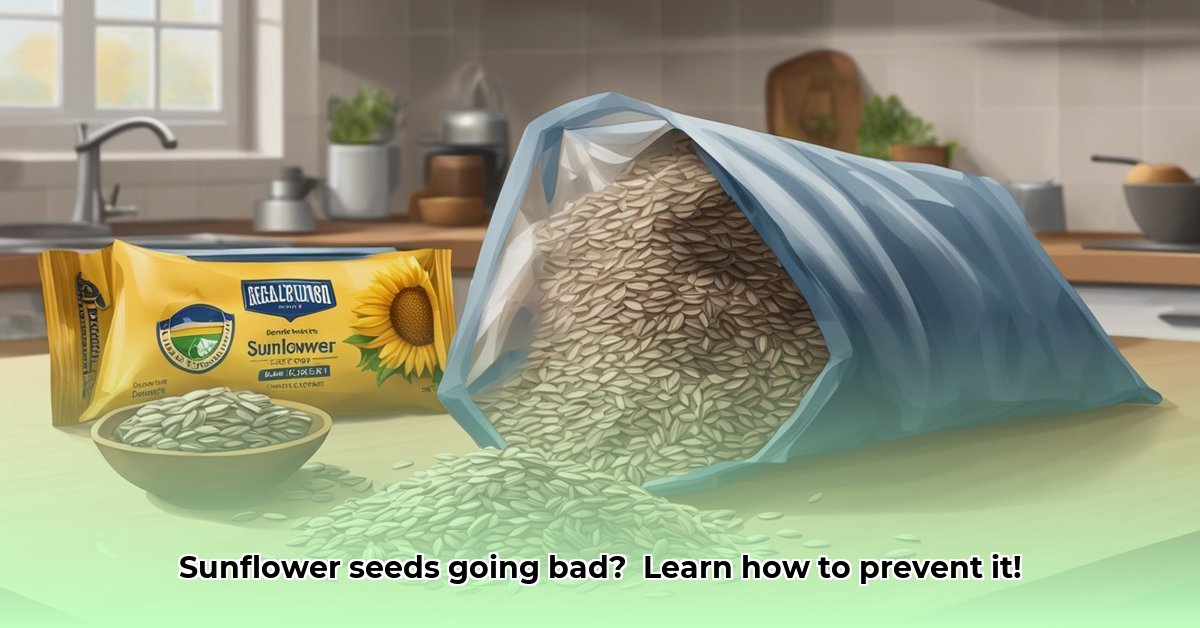Love sunflower seeds? They’re a tasty and healthy treat, but they don’t last forever! Just like how diapers expire, this guide will show you why sunflower seeds go bad, focusing on rancidity, and how to keep them fresh. Learn expert tips to prevent waste and make your seeds last longer – it’s easier than you think to keep them crunchy and delicious!
Do Sunflower Seeds Go Bad? Understanding Spoilage and Rancidity
Let’s face it: we all love a handful of crunchy sunflower seeds. But do those nutritious little nuggets go bad? The short answer is yes. Like any food containing oils and fats, sunflower seeds eventually spoil. Understanding why and how to store them properly can dramatically extend their shelf life, saving you money and minimizing food waste. The primary reason for spoilage is rancidity, where healthy fats oxidize over time, leading to a stale smell and taste. Heat, light, and exposure to air speed up this process, especially for roasted seeds due to increased surface area. The USDA reports that properly stored nuts and seeds can significantly reduce food waste, highlighting the economic and environmental benefits of proper storage.
The Sneaky Enemy: Rancidity and Its Causes
The main culprit behind spoiling sunflower seeds is rancidity. These seeds are packed with healthy fats, but these fats aren’t invincible. Over time, they oxidize – that is, they react with oxygen in the air, altering their nutritional value. This oxidation process leads to that unpleasant, stale smell and taste we all want to avoid. Think of it like leaving a jar of olive oil in direct sunlight for weeks – it’ll go rancid much faster than one kept in a cool, dark cupboard. Heat, light, and exposure to air all speed up this process. This is particularly true for roasted sunflower seeds since the roasting process increases their surface area, exposing more of the fat to oxygen.
Extending the Life of Your Sunflower Seeds: Smart Storage Strategies
Proper storage is your secret weapon in the battle against rancid sunflower seeds. The best methods vary slightly depending on who’s storing them – a farmer, a food processor, or you and me at home. This keeps them safe and ensures every crunchy morsel is as good as the day you bought it.
For Farmers and Large-Scale Processors:
- Harvesting Perfection: Timing is everything! Harvest seeds at peak ripeness for optimal longevity. Gentle harvesting techniques are crucial to minimize damage and bruising, which can accelerate spoilage.
- Drying is Key: Thorough drying after harvesting is paramount. Low moisture content is a major defense against mold and bacterial growth. Think of it as creating an environment where unwanted microorganisms simply can’t thrive. Aim for a moisture content below 10% for optimal storage.
- Cleaning Up: Removing debris, broken seeds, and damaged seeds immediately after harvest prevents contamination from spreading and reduces the risk of pest infestations.
- The Perfect Storage Environment: Large-scale storage requires specialized facilities with precise control over temperature and humidity. Ideal storage temperatures range from 50-60°F (10-15°C) with relative humidity below 60%. Some processors also use modified atmosphere packaging (MAP), which alters the air composition within the packaging to slow down spoilage.
5 Pest Management: Implement integrated pest management strategies to prevent infestations during storage. This may include physical barriers, traps, and, if necessary, approved pesticides.
For Home Storage Heroes (That’s You!):
- Buy Smart, Not Much: It’s important to only buy what you can reasonably use within a few months. Smaller quantities reduce the risk of spoilage. Check the “best by” or “use by” date on the package.
- Airtight is Right: Use airtight containers. Glass jars are ideal because they’re non-reactive and won’t impart any off-flavors. Ensure the lid creates a tight seal. Keep them in a relatively cool, dark, and dry place. Your pantry is fine for short-term storage.
- Refrigeration: A Cool Solution: Storing your seeds in the refrigerator significantly extends their shelf life by slowing down oxidation. Place the airtight container in the crisper drawer for optimal results.
- Freezing: The Ultimate Preservation Method: Freezing is your ultimate weapon against spoilage. Pop those seeds into an airtight freezer bag or container, removing as much air as possible, and they can easily last for a year or even longer, preserving their freshness and flavor.
- The Smell and Sight Test: Before using your seeds, give them a good sniff and a visual check. If they smell rancid (like old oil or paint thinner) or look discolored, it’s best to toss them. Trust your senses! They’re usually pretty reliable.
- Avoid Contamination: Always use clean utensils when scooping seeds from the container to prevent introducing moisture or bacteria.
Storage Recommendations at a Glance:
| Storage Method | Raw Sunflower Seeds Shelf Life | Roasted Sunflower Seeds Shelf Life | Important Notes |
|---|---|---|---|
| Room Temperature | 3-6 months | 1-3 months | Airtight container; cool, dark, dry location; Monitor regularly |
| Refrigerator | 6-12 months | 3-6 months | Airtight container; Maintains freshness longest |
| Freezer | 1-2 years | 6-12 months | Airtight freezer bag or container; best for long term |
Troubleshooting Common Issues: Dealing with Potential Spoilage Problems
- Rancidity: Preventable with good storage. Discard immediately if they smell or taste off. Even a slightly bitter taste indicates rancidity.
- Pest Infestation: Use airtight containers to prevent pests and maintain cleanliness. Inspect seeds regularly for signs of insects. If found, discard the entire batch.
- Mold Growth: Check frequently for mold. Discard any contaminated batch immediately to avoid health risks. Mold often appears as a white or greenish fuzzy growth. Do not attempt to salvage any part of a moldy batch.
- Moisture: Ensure seeds are completely dry before storing to prevent mold growth. If you notice any condensation inside the container, dry the seeds thoroughly before resealing.
So, do sunflower seeds go bad? Yes, but with smart storage techniques, you can keep those seeds fresh, flavorful, and ready to enjoy for a considerably longer time. Proper storage isn’t merely about saving money; it’s about reducing wasted food and getting the most out of these healthy and delicious seeds. Remember, ongoing research continues to refine our understanding of food preservation, so stay tuned for even better storage techniques in the future! The Environmental Protection Agency (EPA) emphasizes the role of consumers in minimizing food waste through effective storage solutions.
How to Extend Sunflower Seed Shelf Life Using Modified Atmosphere Packaging (MAP) and Quality Control
Key Takeaways:
- Oxygen is a primary cause for ruining sunflower seeds, leading to rancidity and spoilage.
- Modified Atmosphere Packaging (MAP) reduces oxygen significantly, extending shelf life.
- Proper storage (cool, dark, dry) remains essential, regardless of packaging.
- Pre-harvest conditions and initial seed quality influence seed longevity. This highlights the importance of proper cultivation techniques among farmers.
- Quality control measures at every stage, from harvest to consumer, are essential for maximizing shelf life.
Understanding Sunflower Seed Spoilage and its Impact
Have you ever opened a bag of sunflower seeds only to find them stale, rancid, or infested? It’s frustrating, right? Sunflower seeds, like many other foods, don’t last forever. They’re susceptible to spoilage due to oxidation (rancidity), insect infestations, and mold growth. These issues primarily stem from exposure to oxygen, moisture, and temperature fluctuations. Spoilage impacts not only taste but also nutritional value, decreasing essential fatty acids and vitamins. The USDA’s food safety guidelines highlight the importance of preventing spoilage to maintain the health benefits of foods like sunflower seeds. Furthermore, rancid oils can develop potentially harmful compounds, making it crucial to prevent spoilage.
The Power of Modified Atmosphere Packaging (MAP) and its Use
How to extend sunflower seed shelf life using modified atmosphere packaging is a game-changer. MAP involves packaging sunflower seeds in an environment with reduced oxygen and increased levels of carbon dioxide or nitrogen. This modified atmosphere slows down or halts the biochemical reactions that lead to spoilage. Think of it as putting your seeds in a protective, oxygen-free bubble. Leading packaging companies highlight that MAP extends the shelf life of various products, including nuts and seeds, by minimizing oxidation and microbial growth.
The specific gas mixture used in MAP depends on the type of seed and desired shelf life. Common mixtures include nitrogen (N2) and carbon dioxide (CO2). Nitrogen acts as an inert filler, while carbon dioxide inhibits microbial growth.
MAP and Storage: A Winning Combination for Shelf Life
While MAP significantly extends shelf life, it’s not a magic bullet. Proper storage practices are vital. Here’s how to maximize the benefits of MAP:
- Seed Selection: Start with high-quality seeds with low moisture content. This is crucial; even the best packaging can’t fix poor initial quality. Farmers should select disease-resistant varieties and implement proper irrigation practices to minimize moisture content.
- Packaging: Choose MAP packaging designed for seeds. The packaging material’s barrier properties are critical to maintaining the
- Gluten Free Meal Prep Ideas for Delicious, Hassle-Free Eating - November 28, 2025
- Gluten Free Meal Prep for Stress-Free and Healthy Eating - November 27, 2025
- Quick And Easy Chicken Thigh Meal Prep For Weight Loss - November 26, 2025










